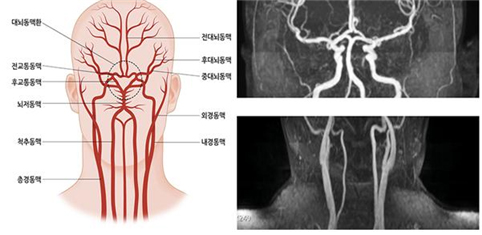페이지 위치
Carotid Ultrasound
- Exam. Time :5~10 mins
- Price :100,000 won
Carotid arteries are the main blood vessels that run from the neck to the brain, and carotid diseases refer to carotid atherosclerosis which is the main cause of the stroke and carotid stenosis. If the carotid arteries are narrowed due to stenosis or angiitis, blood does not circulate well, and if this condition persists, blood will not be delivered to the brain, which increases the risk of stroke.
In order to detect carotid diseases, it is necessary examine the condition of the common and internal carotid arteries. At this time, CT, MRI, and ultrasound are used. Among them, an ultrasound is a basic test due to better accessibility, safety and a shorter examination time.
A simple ultrasound can measure the stenosis of carotid arteries, the degree of arteriosclerosis, the condition of blood flow, and the age of the vessel.
This examination is recommended for patients with hypertension, diabetes, metabolic syndrome, hyperlipidemia, stroke and cardiovascular diseases who require continuous monitoring of blood vessels as the degree of arteriosclerosis is at risk, their family members, people exposed to vascular diseases due to age, smoking and obesity, and adults for prevention of diseases.

1. Results Measured by Carotid Ultrasound
Cholesterol absorbed in the body runs through the blood and builds up in the walls of the blood vessels. Then macrophages or fibrous cells get together again to eat this cholesterol, and this leads to inflammation and fibrosis and the plaques are formed. Plaques can block the carotid blood flow to reduce the cerebral blood flow. And when they fall, they directly flow into the cerebrovascular system to block the end cerebral blood vessels, resulting in cerebral infarctions.
Based on the carotid blood flow velocity and waveform, you can check the existence of stenosis or the degree of stenosis which cannot be detected by an ultrasound.
The thickness of carotid intima and media can be only measured by an ultrasound.

